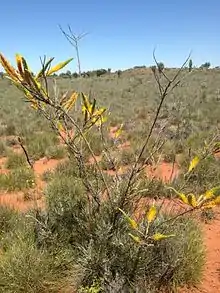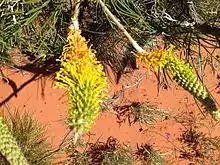Grevillea eriostachya
Grevillea eriostachya, also known as flame grevillea,[2] orange grevillea,[3] or honey grevillea,[4] is a species of flowering plant in the family Proteaceae and is endemic to western parts of Australia. It is a shrub with a leafy base, mostly linear leaves and conical groups of bright yellow flowers on long canes above the foliage.
| Grevillea eriostachya | |
|---|---|
 | |
| Near Kata Tjuta | |
| Scientific classification | |
| Kingdom: | Plantae |
| Clade: | Tracheophytes |
| Clade: | Angiosperms |
| Clade: | Eudicots |
| Order: | Proteales |
| Family: | Proteaceae |
| Genus: | Grevillea |
| Species: | G. eriostachya |
| Binomial name | |
| Grevillea eriostachya | |

Description
Grevillea eriostachya is a shrub that typically grows to a height of 1–3 m (3 ft 3 in – 9 ft 10 in) and has a leafy base with long, arching flowering branches covered with woolly hairs. The leaves are 50–300 mm (2.0–11.8 in) long, those on the flowering stems linear, other leaves sometimes with two to seven linear lobes, the leaves or lobes mostly 1–2 mm (0.039–0.079 in) long. The flowers are borne above the foliage in sometimes branched, conical groups of about 100 to 200 flowers on peduncles up to 400 mm (16 in) long, the rachis 75–200 mm (3.0–7.9 in) long, the flowers at the base of each group opening first. The flowers are green in bud, later bright yellow and woolly-hairy, the pistil 14.5–22 mm (0.57–0.87 in) long. Flowering occurs in all months and the fruit is a follicle 15–22 mm (0.59–0.87 in) long.[5][3][4][6]
Taxonomy
Grevillea eriostachya was first formally described in 1840 by John Lindley in A Sketch of the Vegetation of the Swan River Colony.[7][8] The specific epithet (eriostachya) means "woolly flower-spike".[9]
Distribution and habitat
Flame grevillea grows in heath or shrub on sandplains and is widespread in arid and semi-arid areas of Western Australia, the south-west of the Northern Territory and far north-western South Australia.[2][3][4][5]
Uses
Because of the sweet taste of the shrub's flowers, Aboriginal Australians used it as a sweetener and to add variety to their meals.[10]
References
- "Grevillea eriostachya". Australian Plant Census. Retrieved 13 April 2022.
- "Grevillea eriostachya". FloraBase. Western Australian Government Department of Biodiversity, Conservation and Attractions.
- "Grevillea eriostachya". State Herbarium of South Australia. Retrieved 13 April 2022.
- "Grevillea eriostachya". Northern Territory Government. Retrieved 13 April 2022.
- "Grevillea eriostachya". Australian Biological Resources Study, Department of Agriculture, Water and the Environment: Canberra. Retrieved 14 April 2022.
- "Grevillea eriostachya". Australian Native Plants Society. Retrieved 13 April 2022.
- "Grevillea eriostachya". APNI. Retrieved 14 April 2022.
- Lindley, John (1839). A Sketch of the Vegetation of the Swan River Colony. London: James Ridgway. p. xxxvi. Retrieved 14 April 2022.
- Sharr, Francis Aubi; George, Alex (2019). Western Australian Plant Names and Their Meanings (3rd ed.). Kardinya, WA: Four Gables Press. p. 193. ISBN 9780958034180.
- A. Gould, Richard; Amorosi, Nicholas (1969). Yiwara: Foragers of the Australian Desert. New York: Charles Scribner's Sons. p. 16. ISBN 978-0684310435.